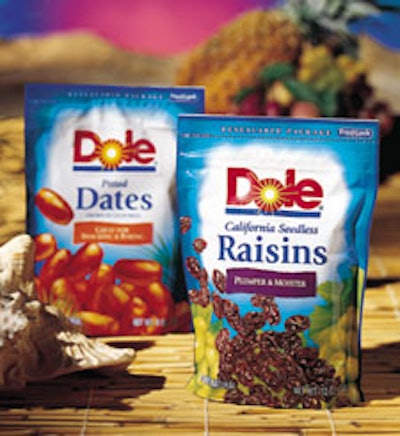As U.S. consumers continue to embrace the stand-up pouch, manufacturers like Dole Packaged Foods take notice. About two years ago, the Westlake Village, CA, company decided to repack its dates from bag-in-box packages to resealable stand-up pouches. So Dole and other well-known dried fruit and nut companies convinced contract packager California Redi-Date (CRD) to move in the same direction.
Late in ’98, the Thermal, CA-based CP did so, investing in a Laudenberg FBM 20 horizontal form/fill/seal machine from Profile Packaging (Sarasota, FL). Pouches made on the machine are resealable thanks to Fresh-Lock® Style 113 zipper material from Presto Products (Appleton, WI).
The hf/f/s equipment operates in CRD’s 125ꯠ sq’ building in Thermal, CA. The structure is one of five on a 42-acre site CRD purchased from Dole in 1997 when Dole sold its dried fruit and nut operation to CRD.
“We sold the plant to California Redi-Date and encouraged them to move in this [the stand-up pouch] direction,” recalls Scott Campbell, a logistics representative with Dole. “They made the investment in the technology and equipment, and we’ve partnered with them and built a very strong relationship,” he says.
CRD packs about 10 different Dole products, including raisins, prunes and dates, in packages ranging from 5 oz to 3 ½ lb. These are sold at retail outlets throughout the U.S. “The pouches offer us improved graphics and increased consumer marketability,” Campbell says. “And though we deal with a variety of contract packagers in North America, California Redi-Date was significant for first getting us into the stand-up pouch with our dried fruit and nut line. Before that, we were in bag-in-box packages.”
Asked about the economics of the switch, Cambell says he prefers not to reveal specifics. However, he says, “with the pouches there’s a slight improvement in that we no longer have to buy a carton and an inner bag.”
Dole specifies film for its pouch-packed product. In this instance, rollstock is supplied by Totai America (Torrance, CA) and Printpack (Atlanta, GA). According to CRD, both vendors provide a 3.6-mil adhesive lamination of 2-mil linear low-density polyethylene sealant layer and 1.6-mil oriented polypropylene. The outer layer is reverse-printed in seven or eight colors. CRD says Totai gravure-prints the OPP while Printpack flexo-prints it.
Zipper works well
Consumers reportedly find the pouches convenient, in large part due to the resealable zipper. The 113 zipper that CRD uses for the Dole packages has an extra-wide offset flange that’s said to have an increased gripping area to make it easier to open. And a single-zipper channel permits secure closing to keep product as fresh as possible after the consumer opens the pouch. The zipper also benefits CRD.
“We learned that the Fresh-Lock zipper runs well on the Laudenberg equipment,” explains Jack Stutz, CRD’s president. “We wanted a zipper that had been on the market and had been proven for stand-up pouch applications.” Now that the CP has used the zipper, Stutz hasn’t been disappointed. “The zipper is probably the easiest part of the whole line. With everything there is to consider in a contract-packaging operation, it’s refreshing not to have to worry about the zipper.”
The LDPE zipper is designed specifically for hf/f/s equipment. It uses patented sealant ribs that are said to seal well to various films. According to Presto, the ribs minimize leakage and permit lower sealing temperatures, which reduce distortion of the film. Lower sealing temperatures allow an hf/f/s line to run at faster speeds.
“For us, production speeds are driven primarily by the product being packaged. It depends on how fast the product can move through the weighing system,” explains Brian Miller, who was CRD’s vice president of operations and contract packaging at the time of Packaging World’s interview. He now serves as a consultant.
CRD often runs pouches at 70/min in the “simplex” mode, 140/min in “duplex” mode. In simplex mode, the machine fills one larger pack at a time; in duplex, it accommodates two smaller pouches simultaneously. The FBM 20 produces pouches up to 11 7/8”Wx 13 7/8”H with a 6” gusset in the simplex mode. Duplex pouches can measure up to 5 7/8”Wx 12”H with a 3 ½” gusset.
Another Presto zipper applied on a Laudenberg FBM 20 was employed successfully at Northfield, MN-based Ryt-way Industries (see PW, Jan. ’99, p. 18, or packworld.com/go/rytway).
Pouches make their mark
The stand-up pouches helped Dole net a 7% increase in category sales in the first year that package configuration was sold. “While packaging isn’t the only marketing element contributing to the increase in sales of dates, it’s definitely a key factor,” says Elaine Leung, senior marketing manager at Dole. In the past year, consumers have seen several new stand-up pouches for Dole items, such as CinnaRaisins®. As photos accompanying this article attest, Dole’s new signature blue graphics create a fresh, contemporary shelf appeal.
Consumers have responded to the pack. “The resealability is a key factor, plus it offers efficient storage and disposal since the bag collapses as the product is used,” she notes. “A lot of our packaging for dried fruit is moving to resealable stand-up pouches with the Fresh-Lock zipper. Consumers tell us they really like this format compared to competitive packages,” such as BIB or canisters.
Planning for more
From January through July, CRD runs the FBM 20 two shifts/day, five days/week. During the busy season of August through December, the equipment runs around the clock, seven days a week, with periodic breaks for cleaning and maintenance. Stutz says the machine produces about 12 million pouches a year, accounting for about 18 million lb of product. “The more it runs, the quicker our payback,” says CRD’s Stutz, who says payback on the FBM 20 will be 18 months.
He tells PW that Dole represents about 20% of the business on the line. The CP also counts Sunsweet, Del Monte and Valley Fig Growers among its customers. It packs dates under its own Calavo and Dromedary brand names and uses the machine for macadamia nuts for Mauna Loa and MacFarms of Hawaii. The CP has also completed test runs of dried tomatoes and fruits, snacks, nuts and candy. Stutz points out that club stores represent a strong potential sales avenue, especially “as they put pressure on a lot of their suppliers to go to the stand-up pouch.”
Looking back, Stutz says, “Dole opened up a window of opportunity with its decision to transition its date packs, and we acted on it. Fortunately, we’re a small enough company that decisions can be made and implemented quickly. It proved to be the right move for us. The start-up of our pouch line has exceeded all of our expectations. And we don’t see anything but continued growth on the horizon.”
CRD is negotiating with several companies that will not only fill up the remaining operating time available on the FBM 20, but also necessitate purchasing another Laudenberg machine (see story, p. 86). “The interest in the stand-up pouches is so serious that we’re on pins and needles,” says Stutz. “If 25 percent of those companies commit [to work with CRD], then life’s great and we get another line and keep rolling. If 50 percent sign orders, we’ve got some problems,” he admits. “If 75 percent commit, we’ll be losing sleep at night.” Judging by Stutz’s tone of voice, it’s a dilemma California Redi-Date is eager to face.

































